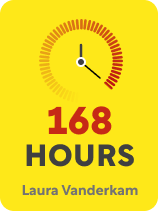

This article is an excerpt from the Shortform book guide to "168 Hours" by Laura Vanderkam. Shortform has the world's best summaries and analyses of books you should be reading.
Like this article? Sign up for a free trial here.
How can you fit a meaningful job, time with your loved ones, and leisure time into your schedule? Is there a way to find time to do everything and not die from burnout?
Many of us would say that it’s impossible. But in 168 Hours: You Have More Time Than You Think, productivity expert Laura Vanderkam argues that you can have a full, satisfying life by managing your time intentionally.
Here are some tips on how to be intentional with your time so you can be both productive and happy.
The Key to Productivity
As Vanderkam points out, we all have 24 hours a day—or 168 hours in a week. However, we don’t get equal amounts done with our 168 hours. For example, Lisa might run a non-profit, go to Pilates class, do volunteer work, and raise a large brood, while Mary might struggle to do all her tasks at her full-time job, leaving her with only enough time and energy to scroll through her phone messages before she goes to sleep.
Why do Mary and Lisa vary wildly in their productivity despite having the same number of hours? Vanderkam contends that this stems from two different approaches to time: Lisa is intentional, actively scheduling her week around her priorities. In contrast, Mary spends much of her time doing low-priority tasks (like unimportant jobs at work) and easy but only mildly satisfying leisure activities (like scrolling through social media).
Vanderkam explains that when you’re intentional with your time, as Lisa is, you do three things: First, you actively schedule your week around your priorities. Second, you understand your “core competencies,” or unique strengths—the things that you’re amazing at or can’t outsource—and spend most of the week using these strengths while delegating tasks that you don’t excel at. And third, you understand that you choose how to spend your time. If you don’t do a task, it’s not because you lacked time but because you didn’t want to do it. By doing these three things, she contends you can live a full, meaningful life.
| What Other Experts Say on How to Be Intentional With Your Time Like Vanderkam, First Things First author Stephen R. Covey suggests that the most effective people intentionally schedule their week around their priorities rather than letting low-priority tasks fill up their schedule. Unlike Vanderkam, Covey doesn’t specify that you focus primarily on the things that you’re good at and can’t outsource. Instead, Covey suggests that you spend most of your time doing significant but not pressing tasks, like planning your long-term goals and investing time in your relationships. And while he agrees that you should minimize the time you spend on insignificant tasks, he doesn’t specify that you should delegate them. Like Vanderkam, Everything is Figureoutable author Marie Forleo emphasizes that you choose how to spend your time—and if you don’t do a task, it simply means that you didn’t prioritize it enough. But Forleo adds that you should adopt a similar approach to other areas of your life, explaining that you can almost always do a task if you try hard enough, but you often won’t. Unless you recognize that you have total responsibility over whether you do something, you’ll continually give excuses and will never make meaningful changes in your life. For example, saying, “I can’t join a gym because I’m broke” absolves you of responsibility, while saying, “I won’t join a gym because I’m broke” motivates you to find more money to join a gym if you want to do it badly enough. |
How to Be Intentional With Your Time
Now that you’ve learned why you need to be intentional with your time in order to build a meaningful life, we’ll go through Vanderkam’s four steps for doing so.
1) Record how you use your 168 consecutive hours. Throughout your day, write down how you spend each hour. Be specific about exactly what you did; instead of writing “dinner,” write “made stir-fry” or “ordered and ate takeout.”
2) Review your time record to discover how you’re currently spending your time. To do so, Vanderkam recommends dividing your activities into major categories, such as sleep, work, or social media. Then, add up the hours you spend on each activity; it likely won’t add up to 168 hours because you lose some time logging them, but it should get fairly close. Then, reflect on your totals. Are you satisfied with the time you’re spending on each activity? What could you do differently? Keep in mind that unlike a day’s time, 168 hours should be plenty of time for all the activities that matter to you.
| Make Recording and Reflecting On Your Time Easier Other productivity experts suggest further techniques to make recording and reflecting on your time easier and more effective. For example, track your time for two weeks instead of one: During the first week, you’re apt to adjust what you do because you’re conscious of the fact that you’re tracking yourself, but you’ll return to normal by the second week. Record your time whenever you perform an existing habit, like getting water every hour, to maximize the chances that you’ll complete your time record instead of giving up on it because it’s too burdensome. Not sure how to categorize an activity? Instead of manually writing down your time, download a time-tracking app on your computer. Many of them automatically track and categorize your activities, so you can focus most of your energy on deciding what categories your offline tasks fall into. Alternatively, consider putting the same activity in multiple categories; for example, if you listen to audiobooks while washing dishes, that might count as both leisure and housework. Keep in mind that if you use this strategy, your total may exceed 168 hours even if you only track one week. When reviewing your time record, focus not just on how much time you’re spending on various activities but when you tend to do them to gain a more accurate picture of how to adjust your schedule. For example, if you always eat breakfast but have a snack one hour later, changing what you eat for breakfast could help you feel fuller and thus avoid the time spent getting the snack. Additionally, focus on how much the tasks you’re stressed out about actually take versus how much time you spend thinking about them. For example, you may feel like you never have enough time for the activities that matter because you have so much email. But you may find that you spend far less time on email than you think and that you’re stressed about it because the anxiety of being constantly available eats up your focus even while you’re doing non-email tasks. So reducing your anxiety around email could help you focus on, and thus feel more satisfied with, the time you spend on other activities that matter even if you don’t increase any of that time. |
3) Identify your unique strengths. You likely know some but not all of them. To discover your overlooked strengths, Vanderkam suggests creating a bucket list with 100 items on it. Then, review your list and start doing some of the cheap and easy ones. By trying several activities, you’ll discover what you like and are good at—and what might count as a unique strength. Be open to the possibility that a unique strength could surprise you. For example, you might take an art history class and discover that analyzing art is a unique strength—and you could use that skill to write a book.
4) Block off time on your schedule first for tasks using your strengths. To ensure you have enough time for what you do best, schedule more time for these tasks and less time for tasks you’re not as good at (we’ll explain how in the next section).
| An Alternate Way to Set Up Your Schedule In The One Thing, Gary Keller suggests an alternate way to set up your schedule. Instead of identifying your unique strengths and building your schedule around them, Keller recommends that you build your schedule around the “one thing” that would have the most impact on various areas of your life. To do so, Keller suggests that you first identify your purpose—the one thing you want your life to be about more than any other. Instead of creating a bucket list of things you want to try, write down some activities and outcomes you’re already passionate about, and pick one activity and one outcome most important to you. Then, combine your activity and outcome to answer the question, “What’s the One Thing I can do that would mean the most to me, so that doing it will make everything else easier or unnecessary?” For example, if you’re passionate about writing (activity) and helping others (outcome), your One Thing might involve finding a job as a grant writer who helps nonprofits get funding. Once you’ve identified your purpose, break it down to determine the “one thing” you can do each day, week, month, and year to achieve this purpose. Design your schedule around this “one thing”: Keller says you should schedule it before your other commitments, and devote at least four hours a day to it as early in your day as possible. The earlier you schedule it, the less likely you are to get distracted by other tasks. |

———End of Preview———
Like what you just read? Read the rest of the world's best book summary and analysis of Laura Vanderkam's "168 Hours" at Shortform.
Here's what you'll find in our full 168 Hours summary:
- How to fit a career, time with your loved ones, and leisure time into your schedule
- How to be intentional with how you spend your time
- Why you're spending too much time watching TV






